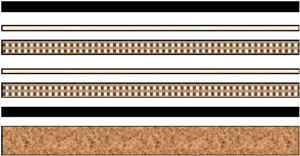Overview of PCB high-frequency board material selection and production and processing methods
1. Definition of PCB high frequency board
High-frequency boards refer to special circuit boards with higher electromagnetic frequencies. They are used in high-frequency (frequency greater than 300MHz or wavelength less than 1 meter) and microwave (frequency greater than 3GHZ or wavelength less than 0.1 meter) PCBs. They are produced on microwave-based copper-clad boards using some of the manufacturing methods of ordinary rigid circuit boards or using special processing methods. Generally speaking, high-frequency boards can be defined as circuit boards with frequencies above 1GHz.
With the rapid development of science and technology, more and more equipment designs are applied in the microwave frequency band (>1GHz) or even in the millimeter wave field (30GHz), which also means that the frequency is getting higher and higher, and the requirements for the substrate of the circuit board are getting higher and higher. For example, the substrate material needs to have excellent electrical properties and good chemical stability, and the loss on the substrate is required to be very small as the power signal frequency increases, so the importance of high-frequency boards is highlighted.
2. Application fields of PCB high frequency board
2.1 Mobile communication products, intelligent lighting systems
2.2 Power amplifiers, low noise amplifiers, etc.
2.3 Passive devices such as power dividers , couplers, duplexers, filters, etc.
2.4 In the fields of automotive anti-collision systems, satellite systems, radio systems, etc., high-frequency electronic equipment is a development trend.
3. Classification of high frequency boards
3.1 Powdered ceramic filled thermosetting materials
A. Manufacturer:
Rogers 4350B/4003C
Arlon 25N/25FR
Taconic TLG series
B. Processing method:
The processing flow is similar to that of epoxy resin/glass woven cloth (FR4), but the board is more brittle and easy to break. The life of the drill bit and the gong cutter is reduced by 20% when drilling and gonging.
3.2 PTFE (polytetrafluoroethylene) material
A: Manufacturer
1 RO3000 series, RT series, TMM series from Rogers
2 AD/AR series, IsoClad series, CuClad series
from Arlon 3 RF series, TLX series, TLY series from Taconic
4 F4B, F4BM, F4BK, TP-2 from Taixing Microwave
B: Processing method
1. Cutting: The protective film must be retained to prevent scratches and indentations
2. Drilling:
2.1 Use a brand new drill bit (standard 130), one piece per stack is the best, and the pressure foot pressure is 40psi
2.2 Aluminum sheet is used as the cover plate, and then a 1mm melamine pad is used to tighten the PTFE plate
2.3 Use an air gun to blow out the dust in the hole after drilling
2.4 Use the most stable drilling rig and drilling parameters (basically, the smaller the hole, the faster the drilling speed, the smaller the chip load, and the slower the return speed)
3. Hole treatment
Plasma treatment or sodium naphthalene activation treatment is beneficial for hole metallization
4.PTH copper deposition
4.1 After micro-etching (micro-etching rate has been controlled at 20 micro-inches), start feeding the board from the oil removal cylinder during PTH.
4.2 If necessary, go through the second PTH and only need to start feeding the board from the expected cylinder.
5. Solder mask
5.1 Pretreatment: Use acid to wash the board, do not use mechanical grinding
5.2 After pretreatment, bake the board (90℃, 30min), apply green oil to cure
5.3 Bake the board in three stages: 80℃, 100℃, 150℃, each for 30min (if oil is found on the substrate surface, it can be reworked: wash off the green oil and reactivate it)
6. Gong board
Place white paper on the circuit surface of the PTFE board, and clamp it with 1.0MM thick FR-4 substrate board or phenolic base board with copper etched off, as shown in the figure:

The burrs on the back edge of the gong plate need to be carefully scraped off by hand to prevent damage to the base material and copper surface, and then separated by sulfur-free paper of appropriate size and visually inspected to reduce burrs. The key point is that the deburring effect of the gong plate process must be good.
4. Process
1. PTFE board processing flow of NPTH
Cutting-drilling-dry film-inspection-etching-corrosion inspection-solder mask-character-spray tin-molding-testing-final inspection-packaging-shipping2
. PTFE board processing flow of PTH
Cutting-drilling-hole treatment (plasma treatment or sodium naphthalene activation treatment)-copper plating-board electroplating-dry film-inspection-graphic electroplating-etching-corrosion inspection-solder mask-character-spray tin-molding-testing-final inspection-packaging-shipping
V. Conclusion
Difficulties in high frequency board processing
1. Copper deposition: It is not easy to copperize the hole wall
2. Control of line gaps and sand holes in pattern transfer, etching, line width
3. Green oil process: control of green oil adhesion and green oil bubbling
4. Strict control of board scratches in each process, etc.







